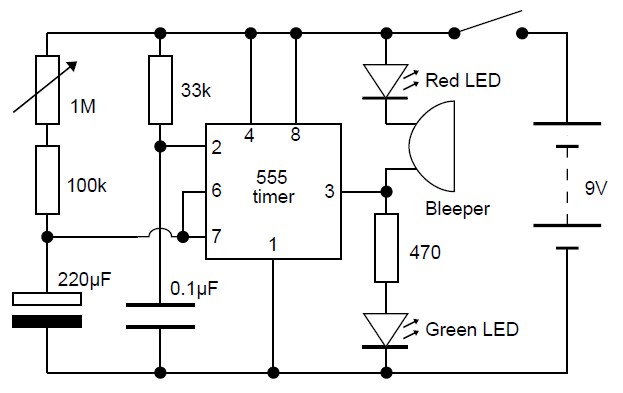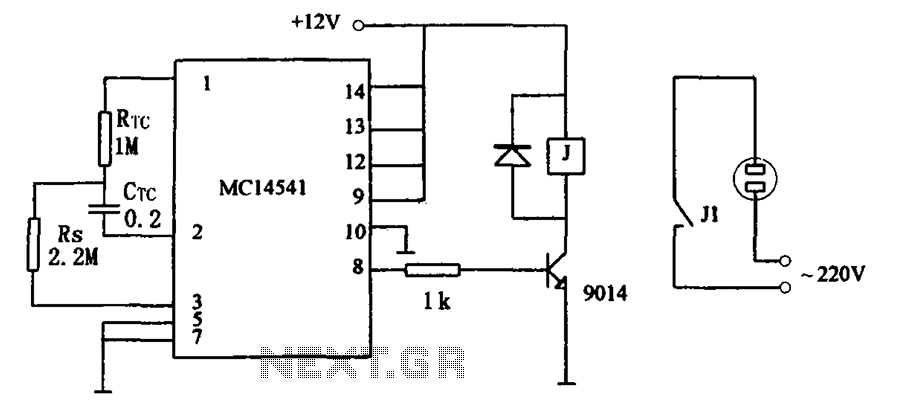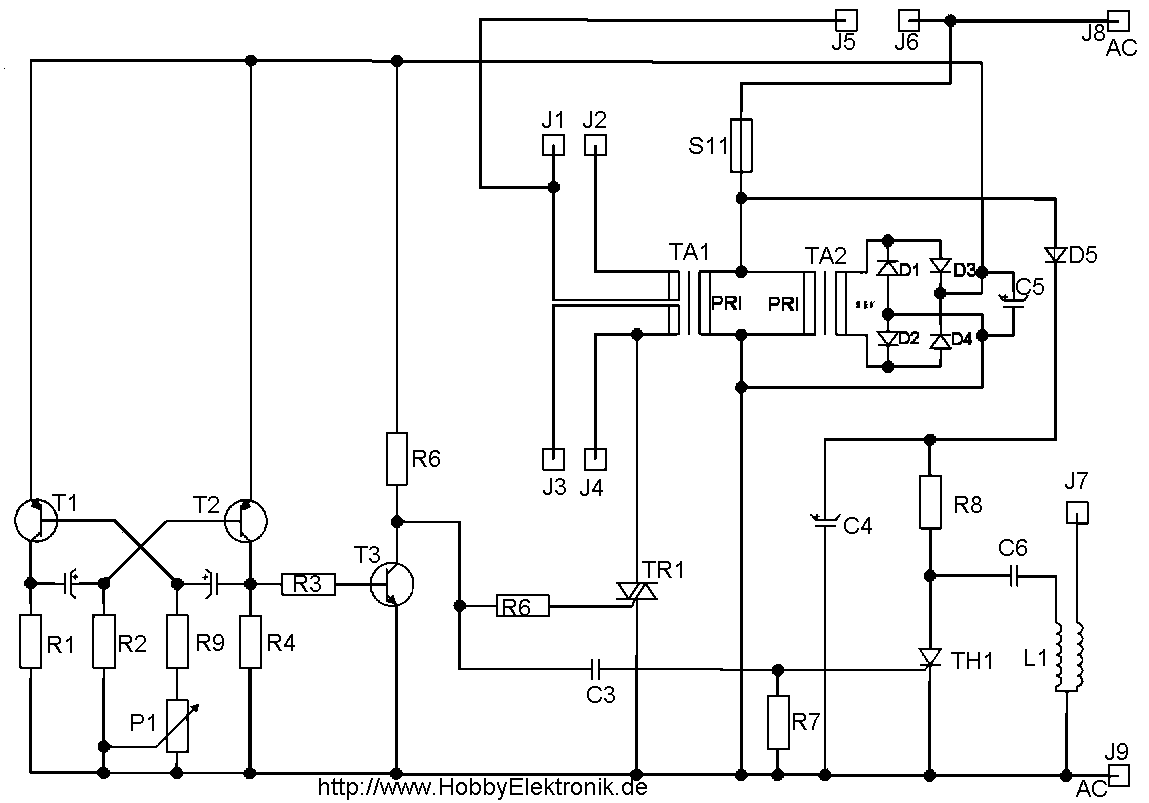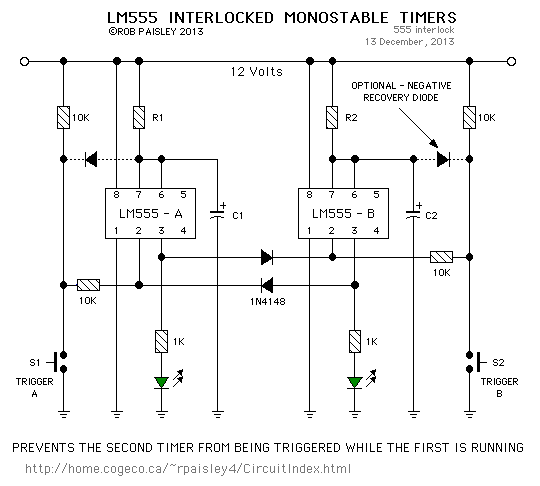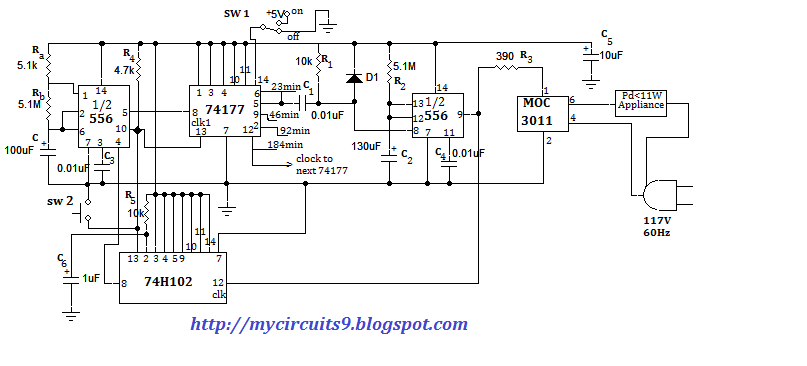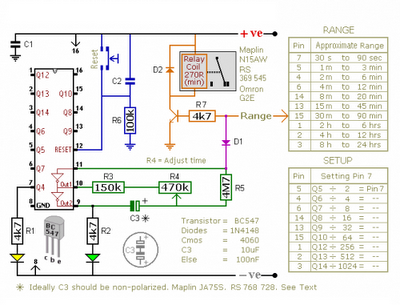
Mains-Powered Timer
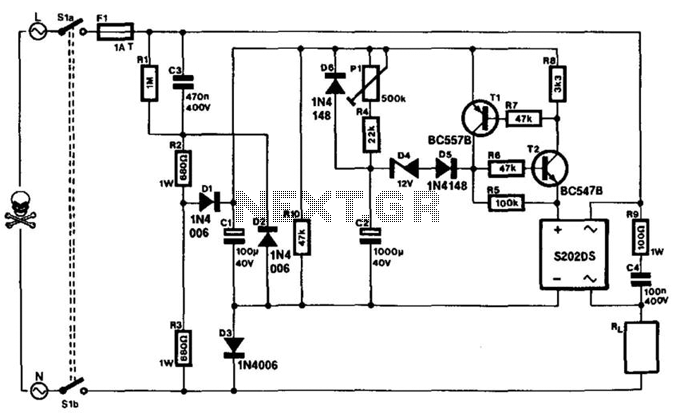
This timer can be integrated into a power line to provide a controllable delay before a load is activated. The mains voltage is reduced by capacitor C3 and rectified to yield approximately 30 V across capacitor C1. This voltage charges capacitor C2 gradually through resistor R4 and potentiometer P1. When the voltage across C2 reaches about 14 V, the electronic switch formed by transistors T1 and T2 activates a solid-state relay (Sharp S202DS). When the mains voltage is disconnected, C2 discharges rapidly through diode D6 and resistor R10. The delay can be adjusted from 15 seconds (with P1 set to minimum resistance) to 5 minutes (with P1 set to maximum resistance). The solid-state relay requires adequate cooling based on the current drawn by the load: no heatsink is necessary for loads up to 1 A, while a heatsink of at least 55 cm is recommended for loads between 1 A and the maximum of 3 A. Safety considerations are critical during circuit assembly, as many components will be at mains potential. For instance, housing the unit in an ABS or other synthetic enclosure is essential. If a potentiometer is utilized for P1, its shaft must be insulated. If a preset potentiometer is employed, it should not be accessible through an opening in the enclosure. Switch S1 is a double-pole, single-throw (DPST) switch that disconnects the circuit from the mains. However, the only safe method to work on the circuit is to unplug the mains socket and allow sufficient time for C3 to discharge.
This timer circuit is designed to introduce a controlled delay in powering a load, making it suitable for applications where a timed activation is necessary. The circuit begins with the reduction of mains voltage through capacitor C3, which is subsequently rectified to approximately 30 V at capacitor C1. This rectified voltage serves to charge capacitor C2 through the combination of resistor R4 and potentiometer P1, allowing for user-adjustable timing.
The charging process of capacitor C2 is critical as it determines when the electronic switch, composed of transistors T1 and T2, will activate the solid-state relay (SSR). The relay, specifically the Sharp S202DS, is responsible for energizing the load once the voltage across C2 exceeds 14 V. This design choice ensures that the load is only powered after the desired delay period, which can be finely adjusted between 15 seconds and 5 minutes based on the settings of potentiometer P1.
Upon disconnection from the mains, capacitor C2 discharges rapidly through diode D6 and resistor R10, ensuring a quick reset of the timing mechanism for the next cycle. The thermal management of the solid-state relay is also a crucial aspect of this design. With loads up to 1 A, the relay can operate without additional cooling, but for higher loads, a heatsink is necessary to prevent overheating and potential failure.
Safety is paramount when working with this circuit due to the presence of mains voltage. The enclosure should be constructed from non-conductive materials such as ABS to prevent accidental electric shocks. If a potentiometer is used for timing adjustments, it is imperative that its shaft is insulated to avoid any risk of electric shock. Additionally, if a preset potentiometer is chosen instead, it must be configured such that it is not accessible through any openings in the enclosure, further enhancing safety.
The circuit includes a DPST switch, S1, which disconnects the entire circuit from the mains supply. However, it is important to note that to work safely on the circuit, the mains plug must be removed from the socket, and adequate time must be allowed for capacitor C3 to discharge fully, ensuring that all components are safe to handle. This comprehensive attention to detail in both functionality and safety makes this timer circuit a reliable choice for controlled load activation in various applications. This timer can be inserted in a power line to provide a controllable delay before a load is energized. The mains voltag e is reduced by C3 and rectified to give about 30 V across CI. This potential charges C2 slowly via R4/P1. When UC2 reaches about 14 V, electronic switch T1/T2 actuates a solid-state relay (a Sharp S202DS). When the mains voltage is removed, C2 discharges rapidly via D6 and RIO. The delay extends from 15 s (PI set to minimum resistance) to 5 min (PI set to maximum resistance). The solid-state relay needs cooling in accordance with the current drawn by the load: at up to 1 A, no heatsink is required; at 1 to 3 A (max), a 55 cm heatsink is advisable. During the building of the circuit, consideration must be given to safety because many parts will be at mains potential.
For instance, fitting the unit in an ABS or other man-made fiber enclosure is a must. If a potentiometer is used for PI, its spindle should be insulated. If a preset is used, it must not be accessible through a hole in the enclosure. Switch SI is a DPST that disconnects the circuit from the mains. Nevertheless, the only way to safely work on the circuit is to unplug the mains socket and allow C3 sufficient discharge time. 🔗 External reference
This timer circuit is designed to introduce a controlled delay in powering a load, making it suitable for applications where a timed activation is necessary. The circuit begins with the reduction of mains voltage through capacitor C3, which is subsequently rectified to approximately 30 V at capacitor C1. This rectified voltage serves to charge capacitor C2 through the combination of resistor R4 and potentiometer P1, allowing for user-adjustable timing.
The charging process of capacitor C2 is critical as it determines when the electronic switch, composed of transistors T1 and T2, will activate the solid-state relay (SSR). The relay, specifically the Sharp S202DS, is responsible for energizing the load once the voltage across C2 exceeds 14 V. This design choice ensures that the load is only powered after the desired delay period, which can be finely adjusted between 15 seconds and 5 minutes based on the settings of potentiometer P1.
Upon disconnection from the mains, capacitor C2 discharges rapidly through diode D6 and resistor R10, ensuring a quick reset of the timing mechanism for the next cycle. The thermal management of the solid-state relay is also a crucial aspect of this design. With loads up to 1 A, the relay can operate without additional cooling, but for higher loads, a heatsink is necessary to prevent overheating and potential failure.
Safety is paramount when working with this circuit due to the presence of mains voltage. The enclosure should be constructed from non-conductive materials such as ABS to prevent accidental electric shocks. If a potentiometer is used for timing adjustments, it is imperative that its shaft is insulated to avoid any risk of electric shock. Additionally, if a preset potentiometer is chosen instead, it must be configured such that it is not accessible through any openings in the enclosure, further enhancing safety.
The circuit includes a DPST switch, S1, which disconnects the entire circuit from the mains supply. However, it is important to note that to work safely on the circuit, the mains plug must be removed from the socket, and adequate time must be allowed for capacitor C3 to discharge fully, ensuring that all components are safe to handle. This comprehensive attention to detail in both functionality and safety makes this timer circuit a reliable choice for controlled load activation in various applications. This timer can be inserted in a power line to provide a controllable delay before a load is energized. The mains voltag e is reduced by C3 and rectified to give about 30 V across CI. This potential charges C2 slowly via R4/P1. When UC2 reaches about 14 V, electronic switch T1/T2 actuates a solid-state relay (a Sharp S202DS). When the mains voltage is removed, C2 discharges rapidly via D6 and RIO. The delay extends from 15 s (PI set to minimum resistance) to 5 min (PI set to maximum resistance). The solid-state relay needs cooling in accordance with the current drawn by the load: at up to 1 A, no heatsink is required; at 1 to 3 A (max), a 55 cm heatsink is advisable. During the building of the circuit, consideration must be given to safety because many parts will be at mains potential.
For instance, fitting the unit in an ABS or other man-made fiber enclosure is a must. If a potentiometer is used for PI, its spindle should be insulated. If a preset is used, it must not be accessible through a hole in the enclosure. Switch SI is a DPST that disconnects the circuit from the mains. Nevertheless, the only way to safely work on the circuit is to unplug the mains socket and allow C3 sufficient discharge time. 🔗 External reference
